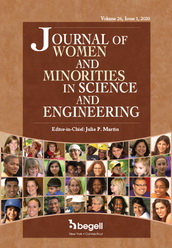
Publicou 6 edições por ano
ISSN Imprimir: 1072-8325
ISSN On-line: 1940-431X
Indexed in
SEEING ONESELF AS A SCIENTIST: MEDIA INFLUENCES AND ADOLESCENT GIRLS' SCIENCE CAREER-POSSIBLE SELVES
 Get access
Get access
RESUMO
Early adolescence is a critical time for fostering girls' awareness and interest in science, engineering, and technology careers as they actively construct their identities. Possible selves theory describes the factors that influence adolescent girls as they create current and future identities. Research suggests that media models can influence views of possible selves, including views of future careers. This study investigated adolescents' academic self-views related to science and the impact of viewing televised scientist characters on these views. This study also assessed adolescents' future career preferences, in general, and specifically in science. Television images of scientists were selected from programs popular among or likely to have been seen by middle school students. The results of this study found that prior to viewing televised scientist characters, girls had lower views of their current but not future academic science self-views than did boys. Viewing televised scientist characters led to a positive change in both adolescent girls' and adolescent boys' future but not current academic science self-views. Adolescent girls were more than twice as likely as boys to list scientific careers as hoped-for future careers; however, adolescent girls also listed scientific careers as feared future careers.
-
Steinke Jocelyn, Portrayals of Female Scientists in the Mass Media, in The International Encyclopedia of Media Studies, 2012. Crossref
-
Flagg Barbara N., Contribution of Multimedia to Girls’ Experience of Citizen Science, Citizen Science: Theory and Practice, 1, 2, 2016. Crossref
-
Steinke Jocelyn, Adolescent Girls’ STEM Identity Formation and Media Images of STEM Professionals: Considering the Influence of Contextual Cues, Frontiers in Psychology, 8, 2017. Crossref
-
Schinske Jeffrey N., Perkins Heather, Snyder Amanda, Wyer Mary, Marsteller Pat, Scientist Spotlight Homework Assignments Shift Students’ Stereotypes of Scientists and Enhance Science Identity in a Diverse Introductory Science Class, CBE—Life Sciences Education, 15, 3, 2016. Crossref
-
Kirby David A., Knowledge Production Between Popular Culture and Scientific Culture, in Handbook of Popular Culture and Biomedicine, 2019. Crossref
-
Wood Sara, Henning Jeremiah A., Chen Luoying, McKibben Taylor, Smith Michael L., Weber Marjorie, Zemenick Ash, Ballen Cissy J., A scientist like me: demographic analysis of biology textbooks reveals both progress and long-term lags, Proceedings of the Royal Society B: Biological Sciences, 287, 1929, 2020. Crossref
-
Pietri Evava S., Johnson India R., Majid Sana, Chu Charles, Seeing What’s Possible: Videos are more Effective than Written Portrayals for Enhancing the Relatability of Scientists and Promoting Black Female Students’ Interest in STEM, Sex Roles, 84, 1-2, 2021. Crossref
-
Shimwell Joe, DeWitt Jennifer, Davenport Carol, Padwick Annie, Sanderson Jonathan, Strachan Rebecca, Scientist of the week: evaluating effects of a teacher-led STEM intervention to reduce stereotypical views of scientists in young children, Research in Science & Technological Education, 2021. Crossref
-
Hite Rebecca, Differences and Similarities in Scientists’ Images Among Popular USA Middle Grades Science Textbooks , European Journal of Mathematics and Science Education, 2, 2, 2021. Crossref
-
Jiang Yang, Popov Vitaliy, Li Yaoran, Myers Perla L., Dalrymple Odesma, Spencer Joi A., “It’s Like I’m Really There”: Using VR Experiences for STEM Career Development, Journal of Science Education and Technology, 30, 6, 2021. Crossref
-
Heck Isobel A., Santhanagopalan Radhika, Cimpian Andrei, Kinzler Katherine D., Understanding the Developmental Roots of Gender Gaps in Politics, Psychological Inquiry, 32, 2, 2021. Crossref
-
Blount Courtland, Lynes Carlos, Richie Jamaal, Narvaez Brittiany, Green Danielle, Herrera Crystal, Sella Sarah, Jara Christian, Ogburn Tim, Nguyen Eric, Toft Lorrel E.B., Lack of racial diversity in cardiopulmonary resuscitation training videos: A cross-sectional analysis, The American Journal of Emergency Medicine, 56, 2022. Crossref
-
Steinke Jocelyn, Applegate Brooks, Penny Jay R., Merlino Sean, Effects of Diverse STEM Role Model Videos in Promoting Adolescents’ Identification, International Journal of Science and Mathematics Education, 20, 2, 2022. Crossref
-
Birman Dina, Oberoi Ashmeet K., Garcia Maria Fernanda, Haarlammert Miryam, Leiva Massiel, Lane Alexandra, Culbreth Caroline, Taylor Hanna, Ruiz-Sorrentini Andrea, Trickett Edison J., In-Between: Late-Arriving Teens in Adult Education Programs Navigating Child and Adult Immigrant Narratives, Journal of Adolescent Research, 37, 3, 2022. Crossref
-
Vieira Carolina C., Vasconcelos Marisa, Using Facebook Ads Data to Assess Gender Balance in STEM: Evidence from Brazil, Companion Proceedings of the Web Conference 2021, 2021. Crossref